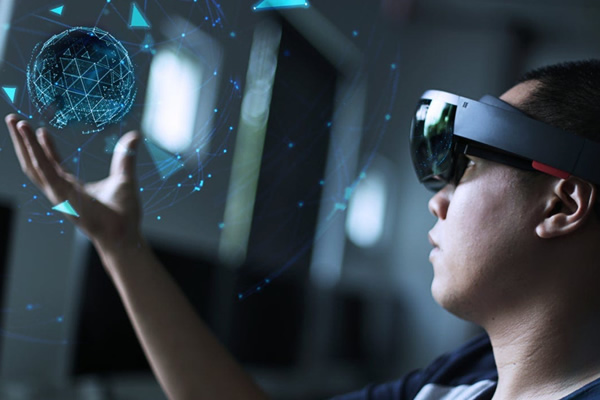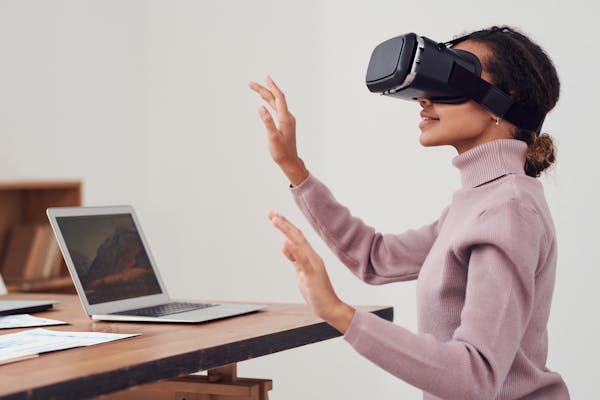
In the realm of technological innovation, few advancements have captured the imagination quite like virtual reality (VR). As society increasingly embraces this immersive digital landscape, there arises a pressing need to delve deeper into the myriad advantages it offers. From revolutionizing industries to transforming educational paradigms, the benefits of virtual reality permeate diverse facets of our lives. Join us on a journey to explore the unparalleled advantages, opportunities, and transformations that the world of VR brings forth.
What is Virtual Reality?
Virtual reality (VR) refers to a computer-generated simulation of an interactive, three-dimensional environment that users can explore and interact with in a seemingly real or physical way. VR technology typically involves the use of specialized headsets or goggles that immerse users in the virtual environment, along with input devices such as controllers or gloves that enable interaction within that environment.
The goal of virtual reality is to create a convincing sensory experience that simulates the real world or an imagined world, allowing users to suspend disbelief and feel as though they are truly present in a different place or scenario. This immersive technology often leverages techniques such as 3D graphics, audio, and motion tracking to enhance the sense of presence and immersion for users.
Virtual reality finds applications across various industries, including gaming, entertainment, healthcare, education, training, simulation, architecture, and more. It enables users to engage in experiences that may be impractical, dangerous, or impossible in the real world, fostering new forms of entertainment, learning, communication, and exploration.
Benefits of Virtual Reality:
Virtual reality (VR) offers a plethora of benefits across numerous domains, revolutionizing industries and transforming user experiences. Some key advantages include:
-
Immersive Experiences:
One of the key benefits of virtual reality (VR) lies in its ability to offer immersive experiences like no other medium. By transporting users to digital environments that feel remarkably real, VR blurs the line between the physical and virtual worlds, engaging multiple senses simultaneously. Through high-quality visuals, spatial audio, and interactive elements, users can deeply engage with the virtual environment, fostering a sense of presence and embodiment.
-
Enhanced Learning and Training:
One of the significant benefits of virtual reality (VR) is Enhanced Learning and Training. By immersing users in realistic simulations, VR creates an interactive and engaging environment conducive to accelerated learning and skill development. Learners can practice tasks in a safe and controlled setting, allowing for repeated trials without real-world consequences. This fosters quicker learning, improved retention, and better transfer of skills to real-world scenarios. Additionally, VR enables personalized learning experiences tailored to individual needs and preferences, further enhancing the effectiveness of training programs.
-
Increased Accessibility:
Increased Accessibility is one of the key benefits of virtual reality (VR), enabling users to access experiences and environments regardless of physical limitations or geographical boundaries. Through VR technology, individuals with disabilities can engage in activities and simulations that might otherwise be inaccessible to them. Moreover, VR eliminates the need for physical travel, making educational resources, entertainment, and social interactions readily available from the comfort of one’s home.
-
Cost Savings and Efficiency:
Cost savings and efficiency stand out as pivotal benefits of virtual reality (VR). By employing VR technology, businesses can significantly reduce expenses associated with travel, training, and prototyping. Virtual meetings conducted through VR platforms negate the need for costly business trips, while immersive training simulations enhance learning outcomes and minimize the need for physical training spaces. Moreover, VR facilitates streamlined prototyping processes, allowing for rapid iterations and adjustments without the expense of physical prototypes.
-
Therapeutic Applications:
One of the significant benefits of virtual reality (VR) lies in its therapeutic applications. VR technology provides a unique platform for immersive experiences that can aid in various forms of therapy, such as exposure therapy for phobias, PTSD treatment, pain management, and rehabilitation exercises. By simulating real-life scenarios in a controlled environment, VR enables therapists to create tailored experiences that help patients confront and overcome their challenges in a safe and controlled setting.
Benefits of Virtual Reality in Health Care

Virtual Reality (VR) offers numerous benefits in the field of healthcare, revolutionizing how medical professionals train, diagnose, and treat patients. Here are some of the key benefits:
-
Medical Training and Education:
The integration of virtual reality (VR) into healthcare brings about significant benefits of virtual reality, particularly in medical training and education. VR offers immersive and realistic simulations that enable medical students and professionals to practice procedures, surgeries, and medical scenarios in a safe and controlled environment. By engaging in hands-on experiences, learners can enhance their skills, improve retention of knowledge, and gain confidence in performing complex tasks.
-
Surgical Planning and Simulation:
One of the key benefits of virtual reality (VR) in healthcare is its application in surgical planning and simulation. VR technology enables surgeons to meticulously plan and rehearse complex procedures in a virtual environment before performing them on actual patients. Through immersive simulations, surgeons can familiarize themselves with patient anatomy, practice different surgical approaches, and anticipate potential challenges or complications.
-
Pain Management and Distraction:
One of the key benefits of virtual reality (VR) in healthcare is its role in pain management and distraction. By immersing patients in captivating virtual environments, VR serves as a powerful tool to alleviate discomfort during medical procedures, reducing reliance on sedatives or analgesics. The immersive nature of VR distracts patients from pain and anxiety, fostering a sense of relaxation and calmness. This not only enhances the overall patient experience but also promotes faster recovery and minimizes the adverse effects associated with traditional pain management methods.
-
Exposure Therapy for Mental Health:
One of the key benefits of virtual reality (VR) in healthcare is its application in Exposure Therapy for Mental Health. Exposure therapy involves gradually exposing individuals to feared objects, situations, or memories in a controlled environment to reduce anxiety or PTSD symptoms. VR allows therapists to create immersive simulations tailored to each patient’s specific triggers, providing a safe and controlled space for exposure.
-
Rehabilitation and Physical Therapy:
One of the key benefits of virtual reality (VR) in healthcare is its application in rehabilitation and physical therapy. Through immersive VR experiences, patients undergoing rehabilitation can engage in interactive exercises and activities tailored to their specific needs, promoting better recovery outcomes. VR-based therapy programs offer motivating environments that encourage patients to participate actively, ultimately improving their mobility, strength, and function. Additionally, healthcare providers can monitor progress more effectively and adjust treatment plans accordingly, maximizing the benefits of rehabilitation interventions.
Benefits of Virtual Reality in Education

Virtual reality (VR) offers numerous benefits in education, revolutionizing traditional learning methods and providing immersive experiences that enhance engagement, understanding, and retention. Some key benefits include:
-
Immersive Learning Environments:
One of the key benefits of virtual reality in education is its ability to create immersive learning environments that transport students into simulated worlds where they can actively engage with educational content. By donning VR headsets, students are fully immersed in 3D environments, allowing them to explore, interact, and learn in ways that traditional methods cannot replicate. This immersive experience enhances engagement, deepens understanding, and improves retention of information, making virtual reality a powerful tool for delivering dynamic and effective educational experiences.
-
Increased Engagement:
The benefits of virtual reality in education are exemplified by increased engagement, as VR immerses students in interactive learning environments, capturing their attention and fostering active participation. By providing dynamic and immersive experiences, virtual reality keeps students deeply engaged in the learning process, leading to heightened interest, motivation, and retention of information. This heightened engagement enhances learning outcomes and encourages students to explore and interact with educational content in ways that traditional methods cannot match, ultimately enriching the learning experience and facilitating deeper understanding across various subjects and disciplines.
-
Personalized Learning:
One of the benefits of virtual reality in education is personalized learning, where instruction is tailored to individual students’ needs and preferences. Through virtual reality, educators can create customized experiences that cater to diverse learning styles and abilities, allowing students to progress at their own pace and focus on areas where they need the most support. This approach enhances engagement, comprehension, and retention, ultimately optimizing the learning journey for each student
-
Accessibility:
One of the key benefits of virtual reality in education is its ability to enhance accessibility for students. Virtual reality eliminates geographical barriers, allowing students from diverse locations to access high-quality educational experiences. This technology also caters to students with disabilities, providing immersive learning opportunities that accommodate various learning needs.
-
Enhanced Collaboration:
Enhanced collaboration, as one of the benefits of virtual reality in education, enables students to interact seamlessly in immersive virtual environments, fostering teamwork and communication skills. Through shared virtual spaces, students can collaborate on projects, participate in group discussions, and engage in problem-solving activities, regardless of their physical location. This feature not only promotes active learning but also facilitates peer-to-peer knowledge sharing, ultimately enhancing the overall educational experience within the realm of virtual reality.
-
Safe Experimentation:
One of the key benefits of virtual reality in education is safe experimentation, wherein students can engage in hands-on learning experiences without real-world risks. Through virtual simulations, learners can conduct experiments, practice skills, or explore hazardous environments in a controlled and safe setting. This allows for immersive learning opportunities that enhance understanding and retention, all while mitigating potential dangers associated with traditional methods.
-
Visualizing Abstract Concepts:
One of the significant benefits of virtual reality in education is its ability to aid in visualizing abstract concepts. Through immersive VR experiences, students can explore complex and abstract ideas in tangible, three-dimensional environments, facilitating deeper understanding and retention. Concepts that are difficult to grasp through traditional teaching methods become more accessible and engaging in VR, leading to enhanced learning outcomes across various subjects and disciplines. This visualization aspect of VR fosters a more intuitive comprehension of abstract concepts, making education more effective and impactful.
-
Motivating STEM Education:
One of the significant benefits of virtual reality in education is its ability to motivate STEM (Science, Technology, Engineering, and Mathematics) learning. By providing immersive and interactive experiences, virtual reality engages students in hands-on exploration of STEM concepts, making learning more enjoyable and compelling. Students can delve into complex scientific phenomena, experiment with engineering designs, or explore mathematical concepts in virtual environments that stimulate curiosity and foster a deeper understanding. This heightened engagement not only sparks interest in STEM subjects but also encourages students to pursue careers in these fields, ultimately contributing to a more skilled and innovative workforce.
-
Cost Savings:
One of the benefits of virtual reality in education is cost savings. While there may be initial investments in VR technology, in the long run, virtual reality eliminates the need for expensive field trips or physical materials. This results in reduced expenses for educational institutions, making education more cost-effective. Additionally, virtual reality can offer simulations and experiences that would otherwise be costly or impossible to replicate in the real world, providing significant value for educational budgets.
-
Real-time Feedback and Assessment:
One of the benefits of virtual reality in education is the provision of real-time feedback and assessment. Through VR platforms, students receive immediate insights into their performance, enabling educators to gauge their understanding and progress instantly. This feature fosters active learning environments where adjustments can be made in real time to address areas of difficulty or reinforce concepts. By leveraging VR for feedback and assessment, educators can tailor instruction more effectively, leading to enhanced learning outcomes and student engagement.
Benefits of Virtual Reality in Business

Virtual Reality (VR) technology offers numerous benefits to businesses across various industries. Here are some of the key advantages:
-
Enhanced Training and Education:
The benefits of virtual reality in business are evident in its ability to revolutionize training and education. By immersing employees in realistic virtual environments, VR enhances learning experiences, allowing for hands-on practice without real-world consequences. This technology facilitates interactive simulations across various industries, from healthcare to manufacturing, improving skill acquisition, retention, and overall performance. With the benefits of virtual reality, businesses can streamline training processes, reduce costs, and ensure that employees are better prepared for their roles, ultimately contributing to organizational success.
-
Cost Saving:
One of the key benefits of virtual reality in business is cost savings. By leveraging VR for training, companies can significantly reduce expenses associated with traditional methods such as travel, equipment, and materials. Additionally, virtual simulations allow for scalable training programs that can reach a wider audience without the need for physical resources, ultimately leading to more efficient and cost-effective training solutions.
-
Increased Productivity:
The utilization of virtual reality (VR) in business leads to increased productivity by enabling streamlined workflows, real-time collaboration, and immersive data visualization. With VR, teams can engage in virtual meetings, design reviews, and training sessions regardless of physical location, fostering faster decision-making and problem-solving. Additionally, VR simulations allow employees to interact with complex data sets and prototypes in a hands-on manner, leading to more efficient product development processes. Overall, the benefits of virtual reality in business translate into heightened productivity through enhanced communication, innovation, and task efficiency.
-
Improved Marketing and Sales:
The benefits of virtual reality in business are exemplified in improved marketing and sales strategies, where VR technology offers immersive experiences for potential customers. By allowing individuals to virtually interact with products or services before purchase, businesses can increase engagement, brand awareness, and ultimately drive conversions. VR enhances the traditional sales process by providing a memorable and impactful way for customers to experience offerings, leading to higher satisfaction and loyalty.
-
Remote Collaboration:
The benefits of virtual reality in business extend to remote collaboration, where teams can seamlessly work together irrespective of physical distances. Through virtual reality platforms, employees can engage in immersive meetings, brainstorming sessions, and collaborative projects as if they were in the same room. This fosters better communication, teamwork, and productivity, while also reducing the need for travel and associated costs. Additionally, remote collaboration in virtual reality creates a sense of presence and connection among team members, leading to more effective decision-making and problem-solving processes.
-
Innovative Product Development:
The benefits of virtual reality in business extend to innovative product development, where VR technology facilitates rapid prototyping and iterative design processes. By creating virtual environments for testing and refining new concepts, businesses can accelerate product development cycles while minimizing costs associated with physical prototypes. This immersive approach enables teams to visualize and interact with products in realistic settings, fostering creativity and uncovering potential design flaws early in the development process. Consequently, companies can bring high-quality products to market more efficiently, gaining a competitive edge and satisfying customer needs effectively.
-
Enhanced Customer Experiences:
One of the standout benefits of virtual reality in business lies in its ability to offer enhanced customer experiences. By leveraging VR technology, businesses can transport customers into immersive virtual environments where they can interact with products, services, or brand experiences in unprecedented ways. Whether it’s offering virtual tours, interactive demos, or personalized simulations, VR enables businesses to create memorable and engaging interactions that differentiate them from competitors, foster deeper connections with customers, and ultimately drive brand loyalty and satisfaction.
-
Health and Safety Training:
One of the key benefits of virtual reality in business is its application in health and safety training. VR simulations offer employees immersive experiences where they can practice safety protocols and procedures in realistic virtual environments, without the inherent risks of traditional training methods. This not only enhances employee engagement and retention but also ensures thorough preparation for real-world scenarios, ultimately leading to a safer work environment and reduced incidents.
-
Data Visualization and Analytics:
One of the key benefits of virtual reality in business lies in its ability to revolutionize data visualization and analytics. By immersing users in virtual environments, businesses can transform complex data sets into interactive and immersive visualizations, enabling deeper insights and more informed decision-making processes. This approach enhances the understanding of data patterns, trends, and relationships, leading to more efficient operations, strategic planning, and ultimately, improved business outcomes.
-
Brand Differentiation:
Virtual reality (VR) technology offers businesses a unique opportunity for brand differentiation by creating immersive and memorable experiences for customers. By integrating VR into their marketing strategies, businesses can showcase their products or services in innovative ways, setting themselves apart from competitors and positioning their brand as forward-thinking and technologically advanced. This utilization of VR enhances brand visibility, attracts tech-savvy consumers, and reinforces the perception of the company as a leader in leveraging the benefits of virtual reality for enhanced customer engagement and satisfaction.
Conclusion
The benefits of virtual reality (VR) present unparalleled advantages across industries, revolutionizing training, education, and customer engagement. Its immersive experiences redefine how we interact with digital environments, offering cost savings, enhanced learning, and innovative product development. Moreover, in healthcare and education, the benefits of virtual reality are evident, with VR’s potential for therapy and personalized learning proving transformative. As we embrace VR’s boundless opportunities, we move towards a future where the physical and digital worlds merge seamlessly, shaping a more immersive and impactful society.


